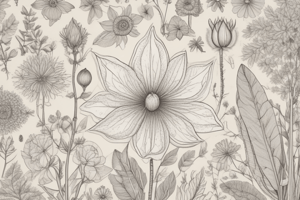Podcast
Questions and Answers
How is the structure of a root adapted for its functions?
How is the structure of a root adapted for its functions?
Roots anchor a plant and absorb water and minerals.
How are herbaceous stems and woody stems alike?
How are herbaceous stems and woody stems alike?
They both consist of phloem and xylem tissue as well as other supporting cells.
How are herbaceous stems and woody stems different?
How are herbaceous stems and woody stems different?
Woody stems are strong and herbaceous stems are flexible.
How does the structure of the leaf help in photosynthesis?
How does the structure of the leaf help in photosynthesis?
Signup and view all the answers
How does dispersal affect seeds' chances of surviving?
How does dispersal affect seeds' chances of surviving?
Signup and view all the answers
Describe the structure and function of the male and female reproductive parts of a typical flower.
Describe the structure and function of the male and female reproductive parts of a typical flower.
Signup and view all the answers
What is a petal?
What is a petal?
Signup and view all the answers
What is germination?
What is germination?
Signup and view all the answers
What is an embryo?
What is an embryo?
Signup and view all the answers
What is transpiration?
What is transpiration?
Signup and view all the answers
What is a sepal?
What is a sepal?
Signup and view all the answers
What is pollination?
What is pollination?
Signup and view all the answers
What is a root cap?
What is a root cap?
Signup and view all the answers
Describe how angiosperms are classified according to the length of their life cycle.
Describe how angiosperms are classified according to the length of their life cycle.
Signup and view all the answers
What happens during fertilization?
What happens during fertilization?
Signup and view all the answers
What are the steps in angiosperm reproduction?
What are the steps in angiosperm reproduction?
Signup and view all the answers
A fertilized egg is called a ___.
A fertilized egg is called a ___.
Signup and view all the answers
When pollen lands on the stigma of a flower __ occurs.
When pollen lands on the stigma of a flower __ occurs.
Signup and view all the answers
A ___ is a ripened ovary.
A ___ is a ripened ovary.
Signup and view all the answers
The reproductive structure of a gymnosperm is the ___.
The reproductive structure of a gymnosperm is the ___.
Signup and view all the answers
Egg cells develop inside a structure called a ___.
Egg cells develop inside a structure called a ___.
Signup and view all the answers
Study Notes
Root Structure and Function
- Roots anchor plants and absorb water and minerals essential for growth.
- The structure includes root caps that protect growing tips.
Stem Comparisons
- Both herbaceous and woody stems contain phloem, xylem tissue, and supportive cells.
- Woody stems are rigid and strong, while herbaceous stems are flexible.
Leaf Structure and Photosynthesis
- Leaves capture sunlight for photosynthesis, storing energy and producing food.
- Chloroplasts are primarily located on the top surface of leaves to maximize light absorption.
- Stomata allow the intake of CO2 and the release of oxygen.
Seed Dispersal and Survival
- Greater distances from the parent plant enhance survival chances due to reduced competition for sunlight and resources.
Flower Reproductive Structures
- Male reproductive parts: stamen consists of filament and anther.
- Female reproductive parts: pistil consists of stigma, style, and ovary.
Key Plant Terms
- Petal: Colorful leaf-like structure of a flower that attracts pollinators.
- Germination: Process where an embryo pushes out of a seed, beginning its growth.
- Embryo: Young plant that develops from a fertilized egg.
- Transpiration: Water evaporation from plant leaves, aiding nutrient transport.
- Sepal: Leaf-like structure that protects a flower bud.
- Pollination: Transfer of pollen from male to female reproductive structures.
Angiosperm Life Cycle and Reproduction
- Classification based on life cycle length involves the production of spores, egg cells, and sperm cells.
- Fertilization results in the formation of a zygote, which develops into a sporophyte.
- A fertilized egg is referred to as a zygote.
- During pollination, pollen lands on the stigma.
Additional Reproductive Structures
- A ripened ovary is known as fruit.
- Gymnosperms reproduce via cones, differentiating them from angiosperms.
- Egg cells develop within ovules.
Studying That Suits You
Use AI to generate personalized quizzes and flashcards to suit your learning preferences.
Description
Test your knowledge of plant structures with these flashcards. Each card focuses on key aspects of roots, stems, and their adaptations. Perfect for students looking to reinforce their understanding of plant biology.




